The Samsung Galaxy S6 and S6 edge Review
by Joshua Ho on April 17, 2015 9:00 AM EST- Posted in
- Smartphones
- Samsung
- Mobile
- Galaxy S6
- Galaxy S6 Edge
NAND Performance: The First UFS Phone
Storage performance is often a critical area for user performance, as applications cannot be cached in RAM at every possible moment. Camera performance is also often limited by storage performance as RAM buffers can only do so much to maintain performance before it’s necessary to commit photos to non-volatile storage.
However due to the memory hierarchy to some extent, storage performance is often hard to notice once it’s at a point where things are “good enough”. Unfortunately, in some cases we can see OEMs failing to include sufficiently performant solid-state storage, which can be a major pain point in the user experience when random read/write performance is low enough that there are noticeable IO pauses as the system has to wait for data to be loaded from storage.
The Samsung Galaxy S6 family is the first shipping implementation of UFS (Universal Flash Storage) 2.0 standard, which makes the internal storage model less like an SD card in nature. When comparing the eMMC 5.1 standard to the UFS 2.0 standard, we see a move from a the 400 MB/s maximum of the eMMC 5.1 standard with HS400 physical link interface to MIPI M-PHY, which allows for a theoretical maximum of around 720 MB/s and should be more efficient in transmitting data than the current eMMC standard. In addition, UFS makes it possible to do full duplex communication, which means that reads and writes can happen simultaneously. There's also a command queue, which helps to avoid inefficiencies that could arise from waiting for commands once a command has been processed by the storage controller, and utilizes the SCSI protocol to facilitate these new features at the interface level.
As for the Galaxy S6 itself, the UFS implementation Samsung is using is Samsung developed. Samsung's current implementation only supports up to 300 MB/s (or 2.4 Gbps) transfer rates as a theoretical maximum, so from an interface perspective it's still not reaching the full capabilities of the standard. Though even at a cap of 300MB/sec, it still stands to be a significant improvement over typical eMMC solutions.
Finally, on a technical note, the 32GB models are of the model KLUBG4G1BD-E0B1 with a maximum queue depth of 16.
In order to test storage performance, we use Androbench with some custom settings to get a reasonable idea of performance in this area, although this test isn’t an exhaustive examination of storage performance by any means.
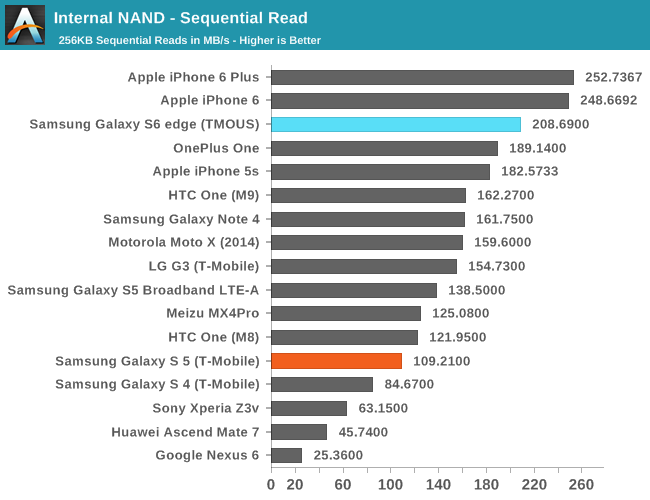
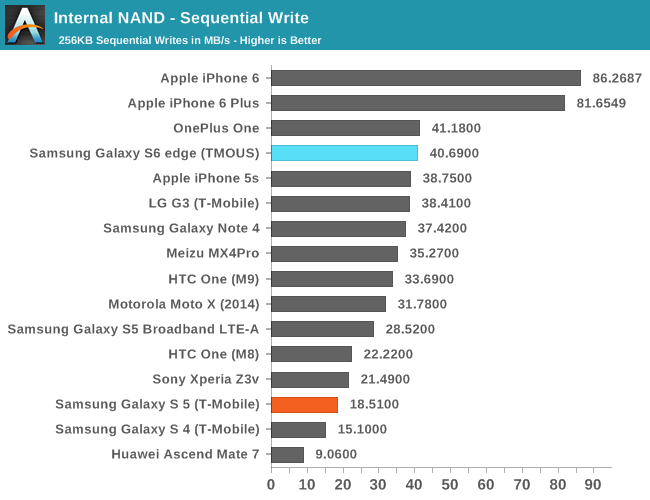
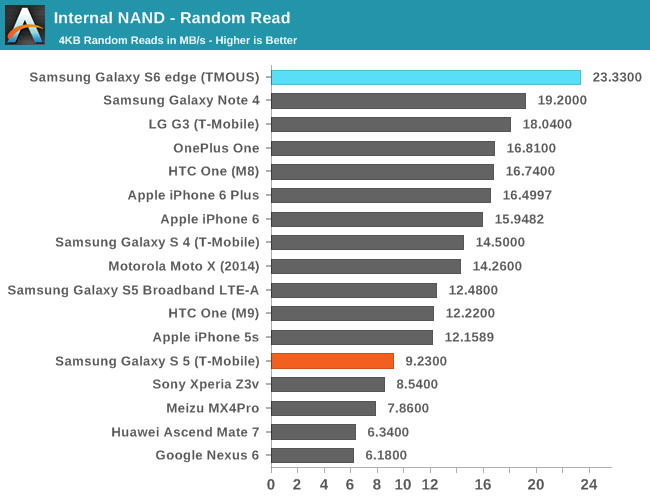
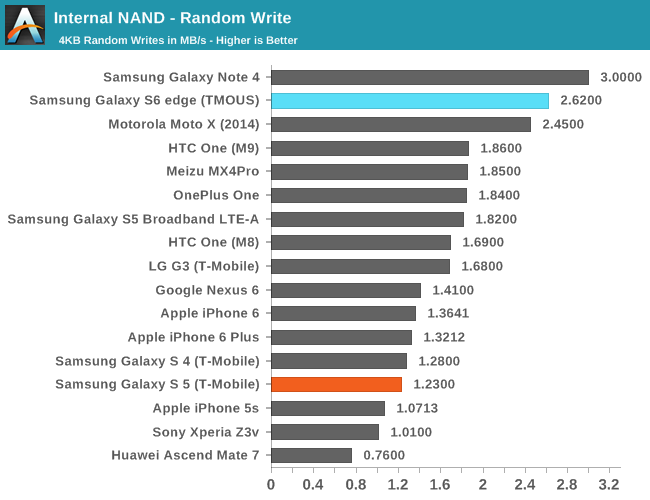
The Galaxy S6 performs rather impressively in our standard storage test, but not as fast as one might have hoped. This is due to the nature of the Androbench 3.6 test, which only tests a single IO thread, which won’t use the UFS storage of the Galaxy S6 to its full extent. In order to see the kind of difference that UFS really makes, I ran the same test again on Androbench 4.x, which does support multiple IO threads. However, as our iOS storage test and Androbench 3.6 don’t support more than a single IO thread we will continue to present both results for now.
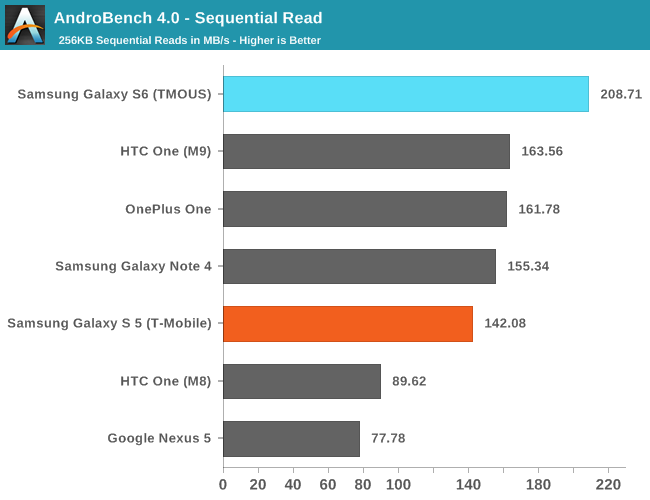
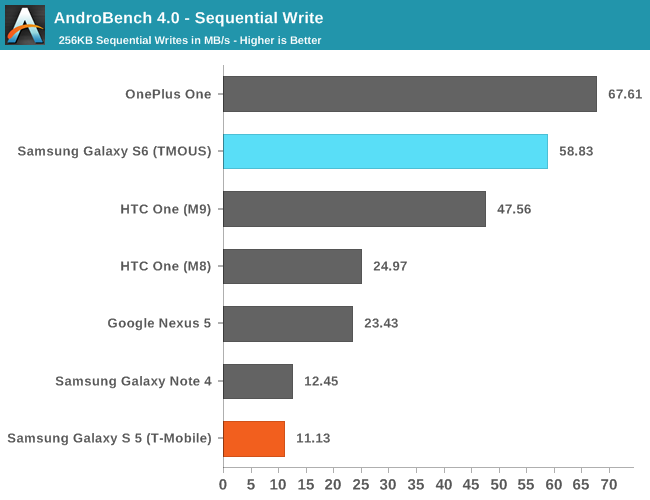
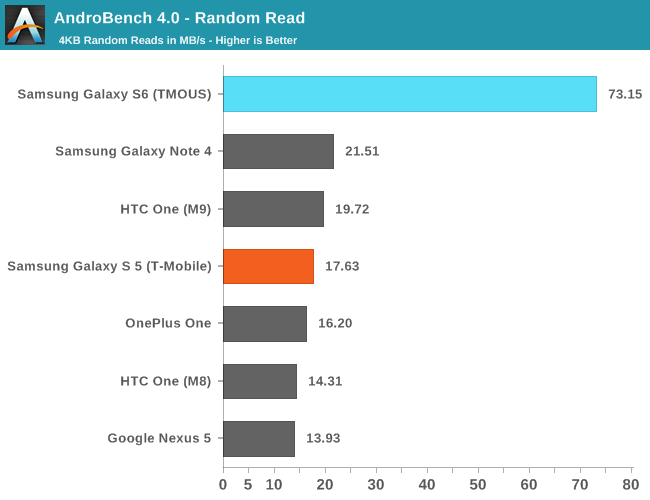
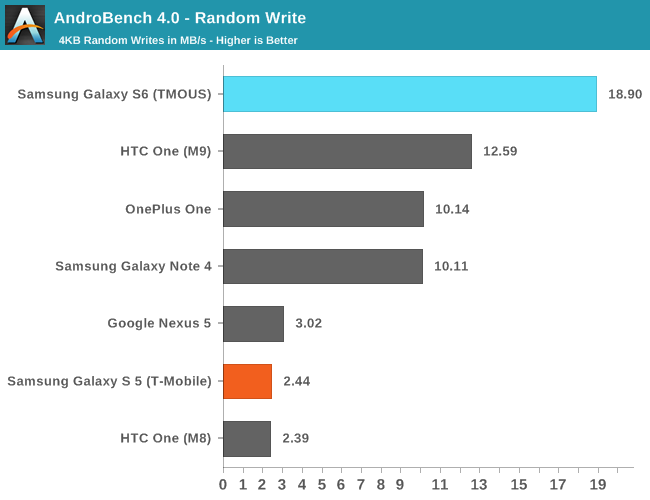
Overall, there are some immense benefits in storage performance here, especially in random IO performance. The Galaxy S6 has some of the fastest storage available in a phone today as far as I can tell given that this is basically a pure MLC solution, and shouldn’t have any real issue with storage performance holding back the rest of the phone over the course of 1-3 years as long as a reasonable amount of free space is kept to allow efficient storage management.


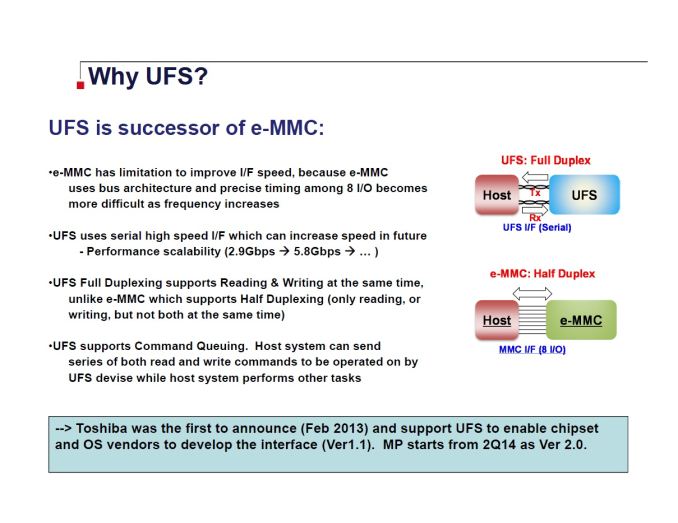








306 Comments
View All Comments
bogda - Saturday, April 18, 2015 - link
External SD on Android is mostly for media files so for me capacity is much more important than performance. Songs and videos will play the same regardless of SD speed.I am not going to watch video at 8x speed.Notmyusualid - Saturday, April 18, 2015 - link
To be honest, I'm happy you are happy with your purchase.To me, it looks gorgeous, but it seems a tiny step down from my GS5. No micro sd slot, no removable battery, no waterproofing (a big one this), and I notice the GFX Bench had worse battery life too.
That record charge time might persuade me, if I were to lose my GS5 drunk etc. But then a second-hand GS5 is a bargin now.
ethebubbeth - Friday, April 17, 2015 - link
My LG G3 has both removable battery and a microSD slot. Here's hoping they continue to carry the torch since it appears that Samsung has dropped it.Ammaross - Friday, April 17, 2015 - link
We'll find out at the end of the month when they announce the LG G4. I'm waiting to see/hear specs on it (officially) before pulling the trigger with an S6. The loss of the SD slot is a bit painful when you have to pony up an extra $100 for a measly extra 32GB....akdj - Friday, April 24, 2015 - link
Or two hundred for incredibly fast internal NAND storage, a bump of 96GB.I've owned each iteration of the Note (business line) except Note 2. Still have the Xoom. iPhones, same --- our employees carry them and I use the 6+ as my personal phone. I didn't upgrade Note 1 --> 2, as I couldn't get out of Note 1 quickly enough (contract). Slow as molasses. 2 changed that, and when it was time to get rid of it, the Note 3 was entirely new 'experience-wise' in comparison. Ten times quicker! I've had the Note 4 since release and I've found the further we move up in Android versions, the less 'control' I've had over where and what storage I'm able to keep on the microSD card
Media, for sure....but for two bills more, over two years is $8/month for 128 GB. I've got the 6+/128 and I've never felt pinched. Even with 3 & 4GB HD movie files I've not compressed. Battery life is incredible on both and other than extended oversea flights I've never had a problem. I also have a TB or 4 at home sharable to the remote phones and tabs from the house but I've never needed to re download extra music or motion while on holiday travel. Best to get out and see the scenery than watch our phones.
128 is a large chunk of internal data to hold. And it's 'not' expensive. If you're a DSLR shooter and use CF cards, motion, or proprietary capture (P2, SxS, RED's SSDs, etc.) --- you know how expensive a 'fast' card is. Even the quickest can't hold a candle to the latest Sammy and Apple MLC/TLC storage. Stairway to Heaven is going to sound the same when you get home but the ability to capture the shots you want, motion and speeds or different resolutions keep the internal NAND's speeds, reliability and prices continue to rise (first two), and drop (price) for these sealed, internal storage modules.
As for batteries ...I've also owned each iPhone and other than Mophie cases on the smaller phones, I've found no such need on the 6+, from the scores shown here...that'll be the case with the S6 as well.
Peichen - Saturday, April 18, 2015 - link
Seems like LG G4 will have removable back, battery and a microSD slot according to leaks.Lonyo - Friday, April 17, 2015 - link
They lost me. My new phone (replacing an S3) arrived yesterday. It has a MicroSD slot and a removable battery.I'm using a MicroSD card in it. It's the one I had in my S3.
Samsung want me to pay $200 premium to upgrade from 32GB to 128GB when I already own 128GB of phone-compatible storage. They can shove it.
Notmyusualid - Saturday, April 18, 2015 - link
+1juxt417 - Wednesday, April 22, 2015 - link
Hope you have everything backed up for if/when that bad boy fails. I gave up on SD cards after mine burnt out.ahw - Friday, April 17, 2015 - link
SD Card slot is the bigger issue, IMO. Samsung has already lost a customer: me. I have an S4 and am eligible for an upgrade. It won't be the S6.